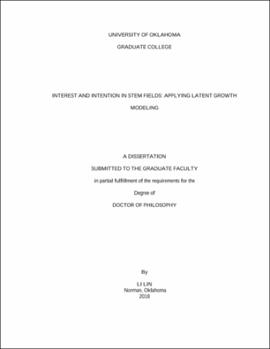| dc.description.abstract | Guided by the proposed paths among interest, intention, and choice variables in Social Cognitive Career Theory (Lent, Brown, Hackett, 1994), the current study utilized latent growth modeling to investigate changes in students’ interest in physical sciences and intention to major in STEM over the course of their undergraduate career. Results indicated that interest in physical sciences was the lowest in students’ second year in college, which may be reflecting the “sophomore slump” phenomenon. Gender, race/ethnicity, math classes taken in high school, realistic learning experiences, investigative learning experiences, implicit theories of math ability, and math ACT were found to be associated with students’ level of interest in physical sciences in their first year of college. Moreover, a higher endorsement of the belief that math ability is fixed was associated with a faster decline in interest in physical sciences. Similarly, gender, race/ethnicity, math classes taken in high school, investigative learning experiences, implicit theories of math ability, and math ACT were found to be associated with students’ level of intention to major in STEM in their first year of college. However, no predictors were found to be associated with the rate of decline in intention to major in STEM. Lastly, models that incorporated students’ chosen academic major also supported that interest in physical sciences and intention to major in STEM in students’ first year in college as well as the rate of decline in intention to major in STEM were associated with the extent to which math was emphasized in students’ chosen majors. | en_US |
